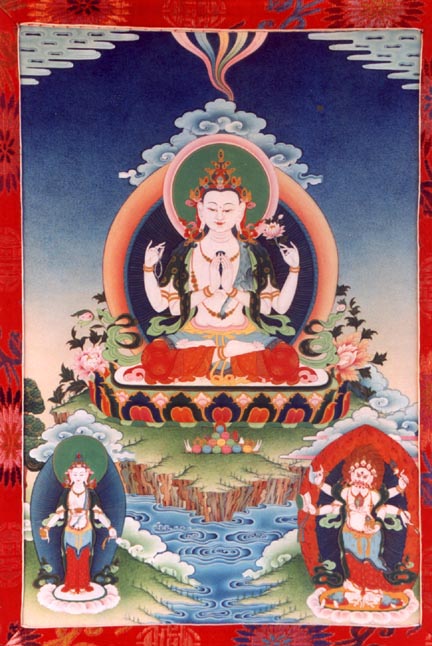
Chenrézigs
Lord of Active-Compassion
This fine thangka of Chenrézigs (sPyan ras gZigs) can be accessed by practitioners in many ways. The image serves to inspire practitioners to engage in kindness-view and kindness-action. It helps to generate a state of selflessness in which practitioners are inspired to put the needs of others before their own. In studying active-compassion, practitioners are asked to focus upon sending their happiness to the innumerable suffering sentient beings and to take their hardships upon themselves.
If one looks closely at the image of Chenrézigs his focused ease demonstrates spacious equipoise. His gaze rests attentively in the all-encompassing space of rigpa, which facilitates assumption of the sufferings of all sentient beings. Chenrézigs allows the suffering of all sentient beings to self-liberate into the natural state – the vastness of the nature of his Mind. Practitioners who engage in the practice of tonglen (gTong len) engage in realizing an awareness which is greater in size than the suffering of all sentient beings. This allows that suffering to dissolve into the nature of Mind.
Practitioners could also use this thangka as a support for yidam practice. The thangka would be placed over their shrine and offerings of food, water and light would be arranged. Offerings allow the practitioner to communicate their appreciation of Chenrézigs’ enlightened qualities. Tantrikas would use this image of Chenrézigs as a support for visualisation. Before employing the image in this manner one would request a qualified Lama to bless or empower the image through the rite of rab-né.
Yidams such as Chenrézigs serve as a symbolic interface with our enlightened state at the level of light and sound. Chenrézigs represents a manner in which our beginningless enlightened state manifests. Tantrikas would engage in the visualisation (light) and recitation of the mantra (sound) of Chenrézigs as a means to realise the non-dual state, which leads them to personally manifest the qualities of the yidam.
Kumar Lama, who painted this thangka,
said:
One can tell the mind state of the painter simply by looking at the image they have
created. If the lines are fluid and crisp this is a sign that the mind state of the painter is calm
and clear. When a painter is painting an image such as Chenrézigs, the painter engages in the
practice of the Yidam in the mornings and evenings whilst working on the image during the daytime.
